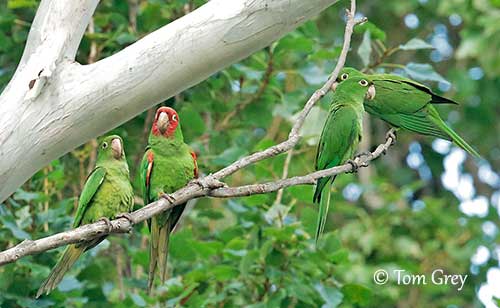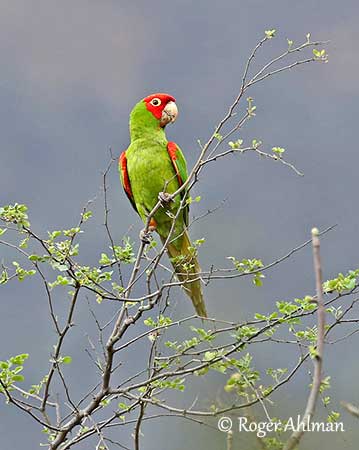
PROTECTION / THREATS / STATUS:
The Red-masked Parakeet is affected by local pet trade in Peru, but it is mainly threatened by habitat loss and fragmentation of the habitat.
But the species occurs in many protected areas, especially in Ecuador.
The size of the population is roughly estimated to number 6,700 mature individuals. This population is suspected to be declining.
The Red-masked Parakeet is currently classified as Near Threatened.
Fr: Conure à tête rouge
Ang: Red-masked Parakeet
All: Guayaquilsittich
Esp: Aratinga de Guayaquil
Ita: Aratinga testarossa
Nd: Ecuadoraratinga
Sd: rödmaskparakit
Photographers:
Roger Ahlman
Pbase Galleries Peru and Ecuador
Tom Grey
Tom Grey's Bird Pictures & Tom Grey's Bird Pictures 2
Text by Nicole Bouglouan
Sources:
HANDBOOK OF THE BIRDS OF THE WORLD vol 4 by Josep del Hoyo-Andrew Elliott-Jordi Sargatal - Lynx Edicions - ISBN: 8487334229
PARROTS OF THE WORLD – An Identification Guide – by Joseph M. Forshaw – Princeton University Press – ISBN 0691092516
BIRDS OF PERU by Thomas S. Schulenberg, Douglas F. Stotz, Daniel F. Lane, John P. O’Neill, Theodore A. Parker III – Princeton University Press 2007– ISBN: 978-0-691-13023-1
What Bird-The ultimate Bird Guide (Mitchell Waite)
Wikipedia, the free encyclopaedia
Related article:
Loro Parque Foundation and Parrots
Red-masked Parakeet
Psittacara erythrogenys
Psittaciformes Order – Psittacidae Family
INTRODUCTION:
The Red-masked Parakeet is found in the lowlands of W Ecuador and NW Peru, up to 2,500 metres of elevation. Escaped cage birds have established feral populations in some parts of the United States, in Hawaii and in Spain.
It frequents a variety of arid habitats, from deciduous forest and adjacent cultivated areas, to dry scrubland and sparsely vegetated desert. It typically feeds on fruits from various plant species.
The Red-masked Parakeet is a cavity-nester, but it often uses abandoned nests, usually woodpecker’s holes. They often nest colonially during the rainy season, and a single clutch is laid every year.
The Red-masked Parakeet is threatened by habitat loss and fragmentation, and it is also affected by illegal trapping for pet trade. The species is currently classified as Near Threatened.

DESCRIPTION OF THE BIRD:
Biometrics:
Length: 29-31 cm
Wingspan: 53-55 cm
Weight: 165-200 g
The Red-masked Parakeet has green plumage overall, but more yellowish on the underparts.
Bend of wings, carpal edge, outermost underwing-coverts and thighs are red. Underwing and undertail are yellowish-green.
On the head, forecrown, lores, cheeks and chin are red.
The hooked bill is horn-coloured. The eyes are dull yellow to orange or brown, with grey inner ring. They are surrounded by a bare, creamy-white eyering. Legs and feet are grey.
Male and female are similar.
The juvenile has green head, without red markings. The plumage is entirely green with sometimes a few orange-red feathers on the yellowish-green carpal edge. The eyes are grey.
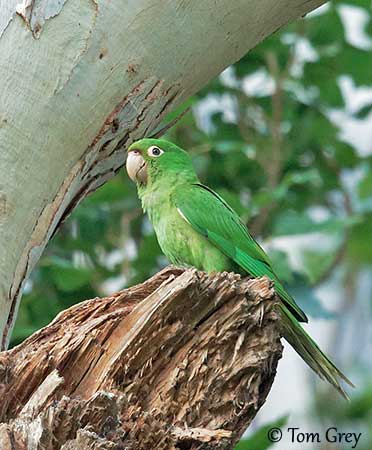
RANGE:
The Red-masked Parakeet is found in the lowlands and Pacific slope of W Ecuador and NW Peru, S to Lambayeque and Cajamarca.
Several feral populations established by escaped cage birds are found around San Francisco, Los Angeles and San Diego in California, and also locally in Florida.
But this species is also found in Spain, Hawaii and Puerto Rico.
HABITAT:
The Red-masked Parakeet frequents lowlands, foothills, mountain valleys, and a large variety of habitats, from humid forest, through deciduous forest, dry scrubland and sparsely vegetated desert, farmed areas and in or around urban centres.
However, it is mainly found in arid habitats, from sea-level up to 2,500 metres of elevation, but mainly below 1,500 metres.
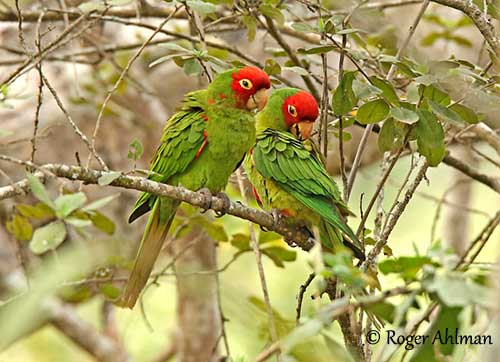
CALLS AND SONGS: SOUNDS BY XENO-CANTO
The Red-masked Parakeet has a wide repertoire of sounds used in flocks, social behaviour, alarm and contact.
When in flight or perched, it gives a screeching “scree-screeah” or “scrah-scrah-scra-scra”. We can also hear a louder, rasping “screet-screet-screet”, a disyllabic call with prolonged second note, and also some buzzing notes.
The alarm call is a rapidly repeated, nasal “eh-eh-eh-eh”. This call becomes louder and higher-pitched according to the threat.
BEHAVIOUR IN THE WILD:
The Red-masked Parakeet feeds on fruits from several plants species such as Saponas purpurea, a fruit with large seeds and watery fleshy pulp. It consumes the pulp but does not eat the seeds. It also feeds on fruits of Hyeronima alchorneoides, but here, it may eat the seeds once cracked. Many other plants are visited through the range.
Feral populations may use bird feeders, especially in California and Florida, but the Hawaiian population does not use them. However, the birds visit numerous plant species growing in these parts of the range.
The Red-masked Parakeet feeds in trees and shrubs by clambering among the foliage with agility to reach the fruits.
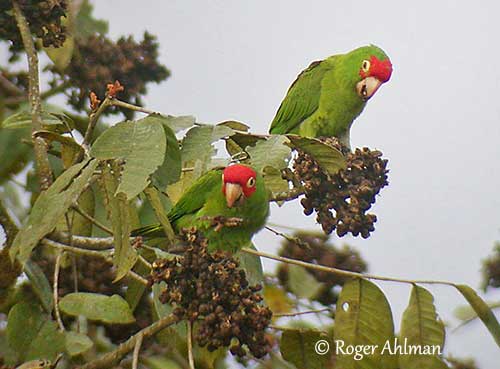
This species usually occurs in flocks of up to 50 individuals, rarely more than 200 birds. They are noisy and gregarious, especially at communal nightime roosts.
During the breeding season, the male performs courtship feeding to the female prior to copulation. While mating, the feathers of both wings and body are raised, especially the breast feathers. But the female does not raise her plumage.
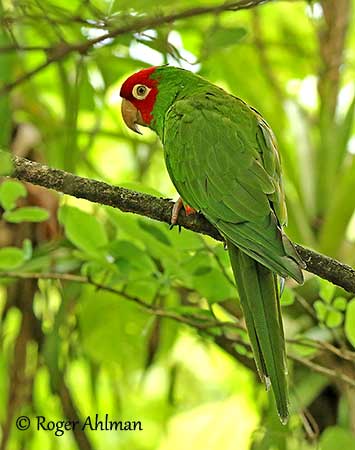
The Red-masked Parakeet is assaulted by diurnal raptors in San Francisco, among them several species from Accipiter and Buteo genera.
The parakeets also take evasive flights from flying seabirds, among them the Great Frigatebird, the White-tailed Tropicbird and the White Tern in Hawaii.
The parakeets may also be frightened by the Rock Pigeon when in flight.
The Red-masked Parakeet is resident, but in more arid areas, it performs marked seasonal or nomadic movements, probably related to food availability.
The flight is fast and direct, with rapid, shallow wingbeats.
REPRODUCTION OF THIS SPECIES:
The breeding season occurs in January/March in SW Ecuador during the rainy season, whereas in Peru, the season may extend through April.
In Hawaii, the breeding period starts in March, with the egg-laying in late June. The first fledglings appear in late August/early September.
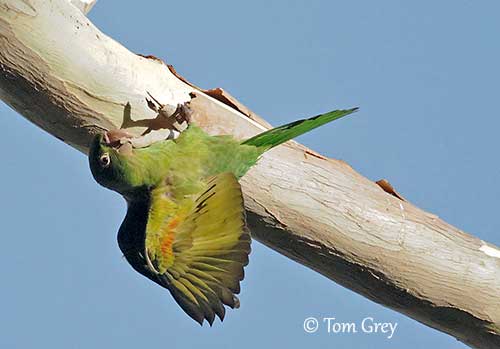
The Red-masked Parakeet is a cavity-nester, but it does not excavate the hole, and prefers to use excavated cavities abandoned by woodpeckers or other species. But it also nests in natural holes in mature trees and there are some records of nests in termite mounds and on cliffs, especially in Hawaii where the species nests in inland rock cliffs.
The pair defends only a small area close to the nesting cavity. In Peru, the pairs are solitary nesters, whereas in Hawaii, they appear to nest colonially in cliffs.
The female lays 3-4 white eggs during the rainy season, and she incubates during 23-24 days. At hatching, the chicks are blind and naked. They are fed by the adults, probably mainly by the female. They fledge six weeks after hatching, but they still depend on adults for food for some weeks.
